fuel CHEVROLET TRACKER 1995 Owners Manual
[x] Cancel search | Manufacturer: CHEVROLET, Model Year: 1995, Model line: TRACKER, Model: CHEVROLET TRACKER 1995Pages: 354, PDF Size: 18.24 MB
Page 6 of 354
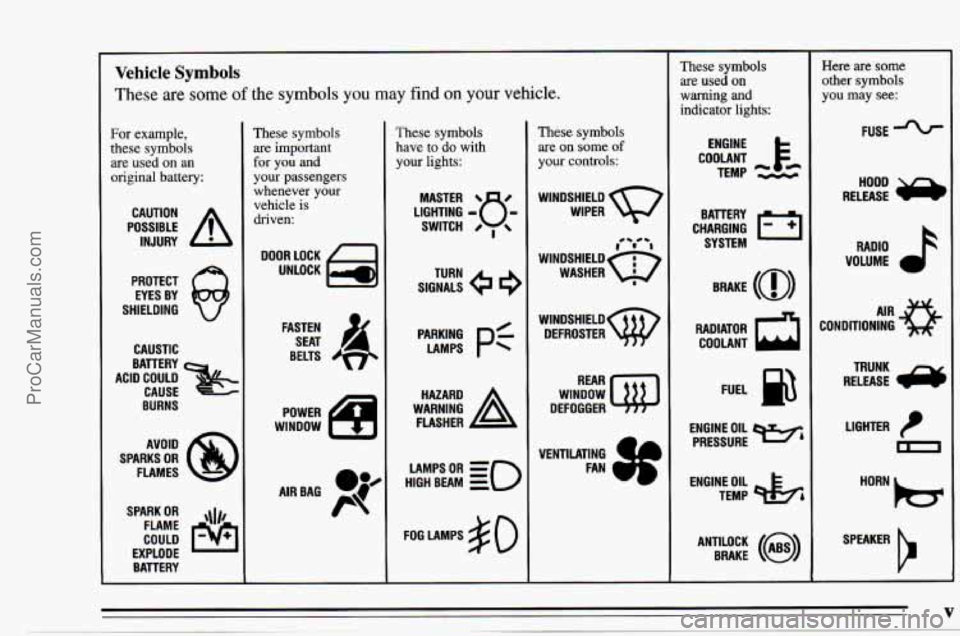
~~ Vehicle Symbols
These are some of the symbols you may find on your vehicle.
For example,
these symbols
are used on an
original battery:
POSSIBLE A
CAUTION
INJURY
PROTECT EYES BY
SHIELDING
CAUSTIC
ACID COULD BATTERY
CAUSE
BURNS
SPARK
OR ,\(I,
COULD FLAME
EXPLODE BAVERY
These symbols are important
for
you and
your passengers
whenever your
vehicle
is
driven:
DOOR LOCK
UNLOCK
FASTEN SEAT
&,
BELTS
POWER
WINDOW
LR
AIRBAG P@K
These symbols
have to
do with
your
lights:
SIGNALS e
TURN
PyN;
pf
WARNING A
HAZARD
FLASHER
HIGH
LAMPSoR BEAM = =o
FOG LAMPS $0
These symbols
are on some of
your controls:
WINDSHIELD
WIPER
,-/ 'I
WINDSHIELDQ
WASHER 8
wlNDSHIELDw DEFROSTER
WINDOW
DEFOGGER
These symbols are used on
warning and
indicator lights:
COOLANT F-
TEMP --
ENGINE
CHARGING
I-1
BATTERY SYSTEM
BRAKE
(a)
RADIATOR a
COOLANT
FUEL
ENGINE OIL
e,
PRESSURE
TEMP
OIL pk;
ANTIU)CK BRAKE (i)
~
Here are some
other symbols
you may see:
FUSE -%-
RADIO h
VOLUME a
CONDITIONING AIR 43
LIGHTER
m
SPEAKER
b
V
. ~ ProCarManuals.com
Page 53 of 354
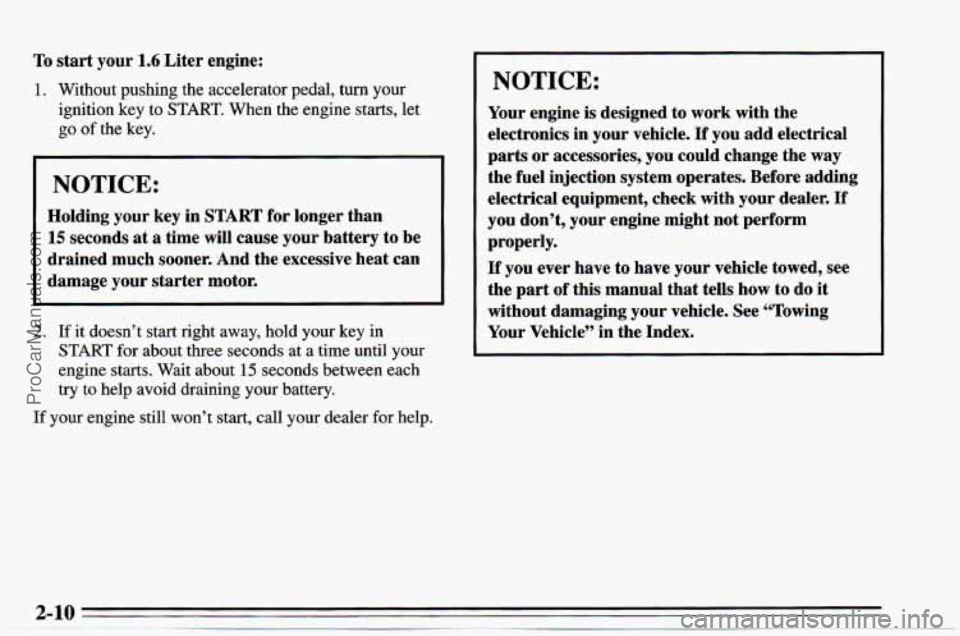
To start your 1.6 Liter engine:
1. Without pushing the accelerator pedal, turn your
ignition key to
START. When the engine starts, let
go
of the key.
NOTICE:
Holding your key in START for longer than
15 seconds at a time will cause your battery to be
drained much sooner. And the excessive heat can
damage your starter motor.
2. If it doesn’t start right away, hold your key in
START for about three seconds at a time until your
engine
starts. Wait about 15 seconds between each
try
to help avoid draining your battery.
If your engine still won’t start, call your dealer for help.
I
~ NOTICE:
~
Your engine is designed to work with the
electronics in your vehicle.
If you add electrical
parts or accessories, you could change the
way
the fuel injection system operates. Before adding
electrical equipment, check with your dealer.
If
you don’t, your engine might not perform
properly.
If you ever have to have your vehicle towed, see
the part
of this manual that tells how to do it
1 without damaging your vehicle. See “Towing
Your Vehicle” in the Index.
i
ProCarManuals.com
Page 56 of 354
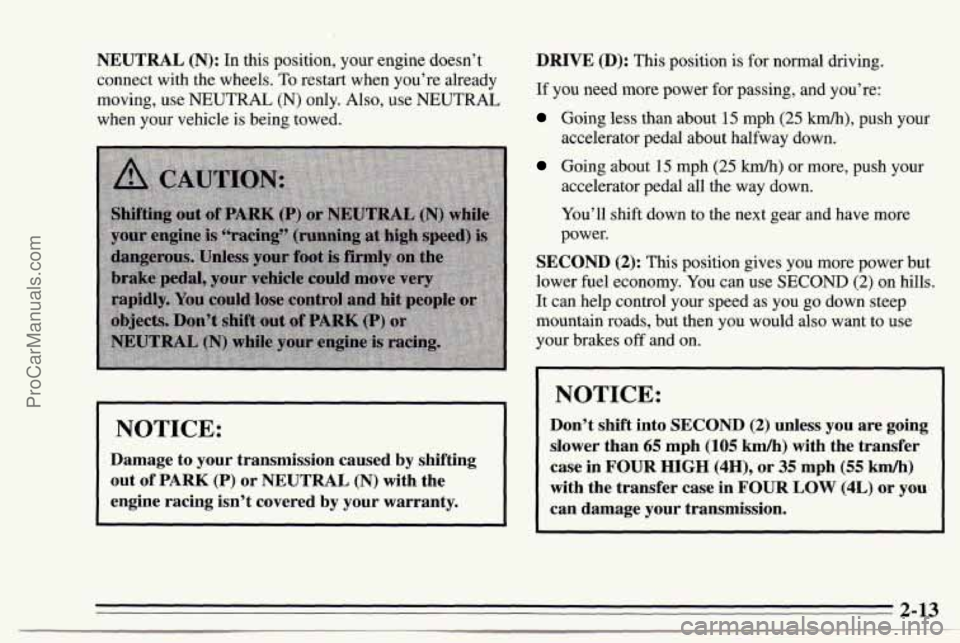
NEUTRAL (N): In this position, your engine doesn’t
connect with the wheels. To restart when you’re already
moving, use NEUTRAL
(N) only. Also, use NEUTRAL
when your vehicle is being towed.
NOTICE:
Damage to your transmission caused by shifting
out of PARK
(P) or NEUTRAL (N) with the
engine racing isn’t covered
by your warranty. DRIVE (D):
This position
is for normal driving.
If you need more power for passing, and you’re:
Going less than about 15 mph (25 km/h), push your
accelerator pedal about halfway down.
Going about 15 mph (25 kmk) or more, push your
accelerator pedal
all the way down.
You’ll shift down to the next gear and have more
power.
SECOND (2): This position gives you more power but
lower fuel economy. You can use SECOND
(2) on hills.
It can help control your speed as you go down steep
mountain roads,
but then you would also want to use
your brakes off and on.
NOTICE:
Don’t shift into SECOND (2) unless you are going
slower than
65 mph (105 kmh) with the transfer
case
in FOUR HIGH (4H), or 35 mph (55 km/h)
with the transfer case in FOUR LOW (4L) or you
can damage your transmission.
2-13
ProCarManuals.com
Page 57 of 354
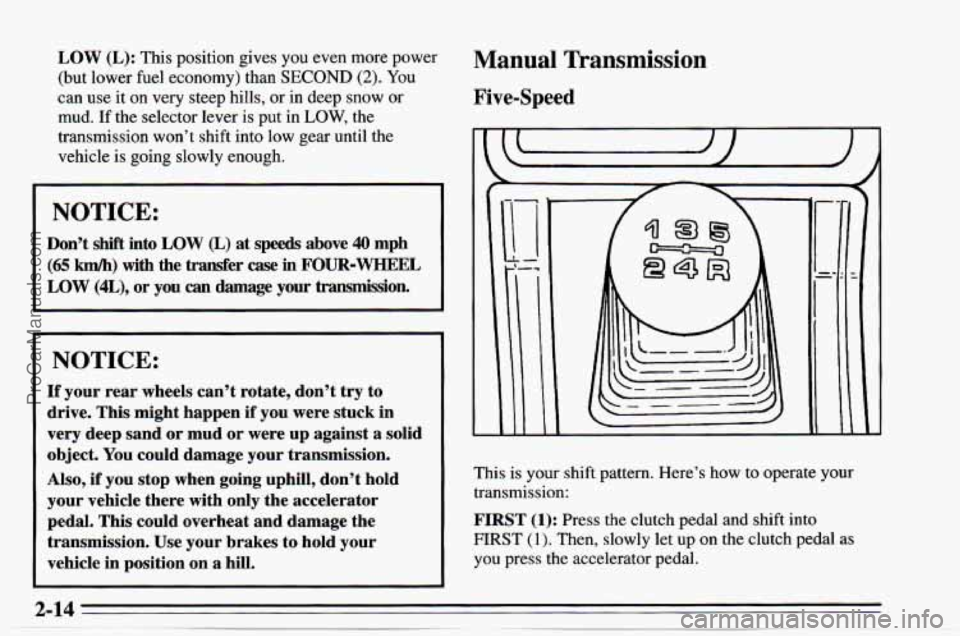
LOW (L): This position gives you even more power
(but lower fuel economy) than
SECOND (2). You
can use it on very steep hills, or in deep snow or
mud. If the selector lever is put in LOW, the
transmission won’t shift into low gear until the
vehicle is going slowly enough.
NOTICE:
Don’t shift into LOW (L) at speeds above 40 mph
(65 km/h) with the transfer case in FOUR-WHEEL
LOW (4L), or you can damage your transmission.
NOTICE:
If your rear wheels can’t rotate, don’t try to
drive. This might happen
if you were stuck in
very deep sand or mud or were up against a solid
object.
You could damage your transmission.
Also,
if you stop when going uphill, don’t hold
your vehicle there with only the accelerator
pedal. This could overheat and damage the
transmission. Use your brakes to hold your
vehicle in position on a hill.
Manual Transmission
Five-Speed
This is your shift pattern. Here’s how to operate your
transmission:
FIRST (1): Press the clutch pedal and shift into
FIRST
(1). Then, slowly let up on the clutch pedal as
you press the accelerator pedal.
ProCarManuals.com
Page 59 of 354
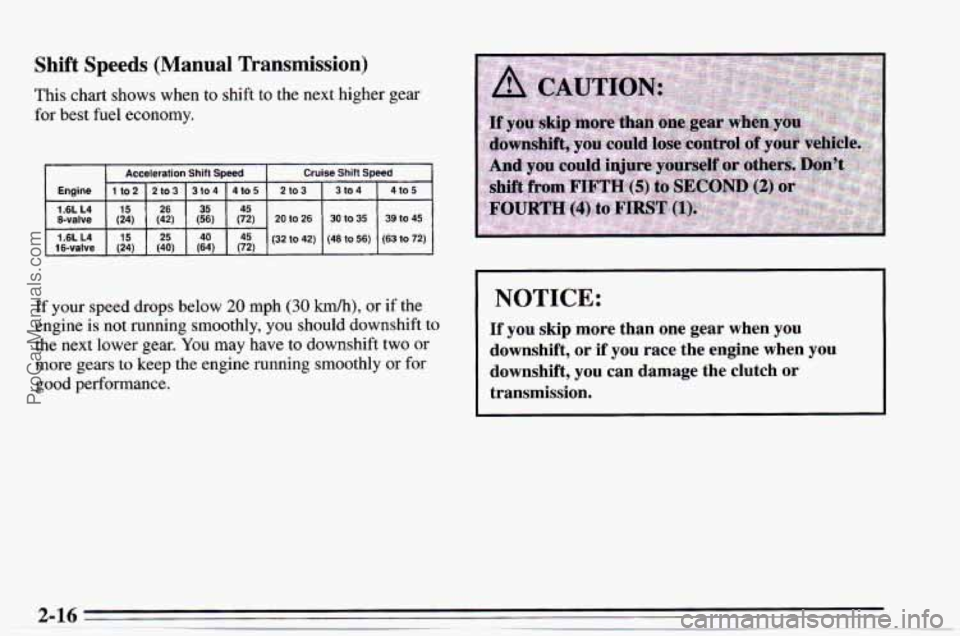
Shift Speeds (Manual Transmission)
This chart shows when to shift to the next higher gear
for best fuel economy.
Acceleration Shift Speed Cruise Shift Speed
1t02 I2to3 I3to4 f4to5 2to3 I 3to4 I 4to5 1 1.6L L4 15 26 35 45
&valve (24) (42) (56) (72) 20 to 26 30 to 35 39 to 45
16-valve (24)
(40) (64) (72)
1.6L L4 15 25
40 45 (32 to 42) (48 to 56) (63 to 72)
If your speed drops below 20 mph (30 km/h), or if the
engine is not running smoothly,
you should downshift to
the next lower gear. You may have to downshift two or
more gears to keep the engine running smoothly or for
good performance.
I NOTICE:
If you skip more than one gear when you
downshift, or if you race the engine when you
downshift,
you can damage the clutch or
transmission.
ProCarManuals.com
Page 62 of 354

Transfer Case
The transfer case shift lever is on the floor to the right of
the driver. Use this lever to shift into and out of
four-wheel drive. An indicator light comes on when the
transfer case is in FOUR-WHEEL
HIGH (4H) or
FOUR-WHEEL
LOW (4L).
TWO-WHEEL HIGH (2H): This setting is for driving
in most street
and highway situations. Your front axle is
not engaged in two-wheel drive.
FOUR-WHEEL HIGH (4H): This setting engages
your front axle
to help drive your vehicle. Use
FOUR-WHEEL HIGH (4H) when you need extra
traction, such as on wet or icy roads, or in
most off-road
situations.
NEUTRAL (N): Shift to this setting only when your
vehicle needs to be towed.
FOUR-WHEEL LOW (4L): This setting also engages
your front axle to give you extra traction, but should be
used only for driving downhill
or on slippery surfaces
when you're driving slower than
35 mph (55 km/h).
Remember that driving in FOUR-WHEEL HIGH (4H)
or FOUR-WHEEL LOW (4L)
may reduce fuel
economy. Also, driving in four-wheel drive on dry
pavement could cause your tires to wear faster and make
your transfer case harder
to shift.
2-19
ProCarManuals.com
Page 83 of 354

Standard Cluster
r-
‘H
@
UNLEADED
FUEL ONLY
Your instrument cluster is designed to let you know at a
glance how your vehicle is running. You’ll know how
fast you’re
going, about how much fuel you have left, and
many other things you’ll need to know to drive
safely and economically.
2-40
ProCarManuals.com
Page 89 of 354
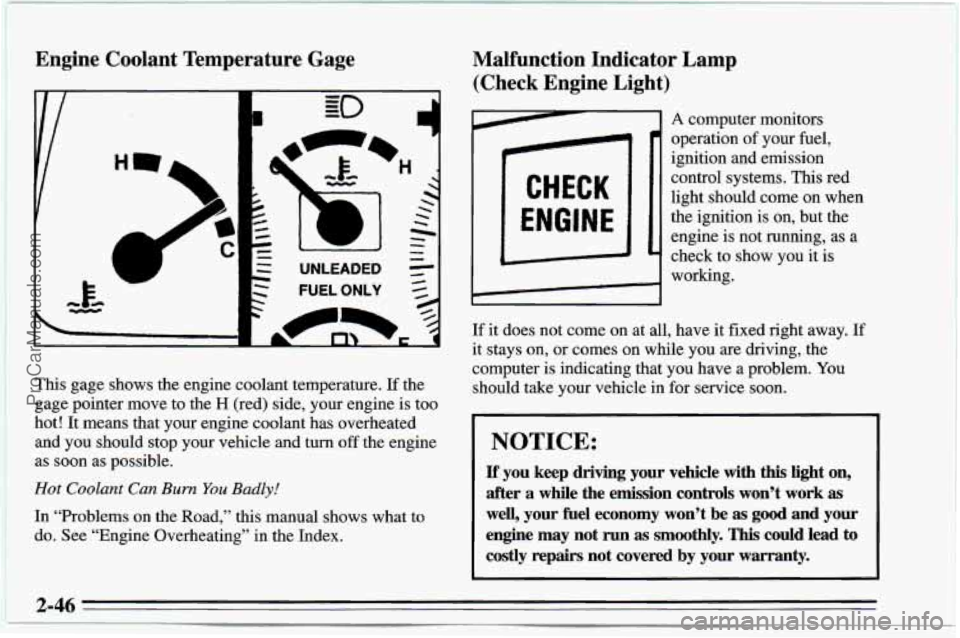
Engine Coolant Temperature Gage
This gage shows the engine coolant temperature. If the
gage pointer move to the
H (red) side, your engine is too
hot! It means that your engine coolant has overheated
and you should stop your vehicle and turn
off the engine
as soon as possible.
Hot Coolant Can Burn You Badly!
In “Problems on the Road,” this manual shows what to
do. See “Engine Overheating”
in the Index.
Malfunction Indicator Lamp
(Check Engine Light)
A computer monitors
operation
of your fuel,
ignition and emission
control systems. This red
light should come
on when
the ignition
is on, but the
engine
is not running, as a
check to show you it is
CHECK
ENGINE
Da i
I
If it does not come on at all, have it fixed right away. If
it stays on, or comes on while you are driving, the
computer is indicating that you have a problem. You
should take your vehicle in
for service soon.
NOTICE:
If’ you keep driving your vehicle with this light on,
after a while the emission controls won’t work
as
well, your fuel economy won’t be as good and your
engine may not
run as smoothly. This could lead to
costly repairs not covered by your warranty.
2-46
I
ProCarManuals.com
Page 91 of 354
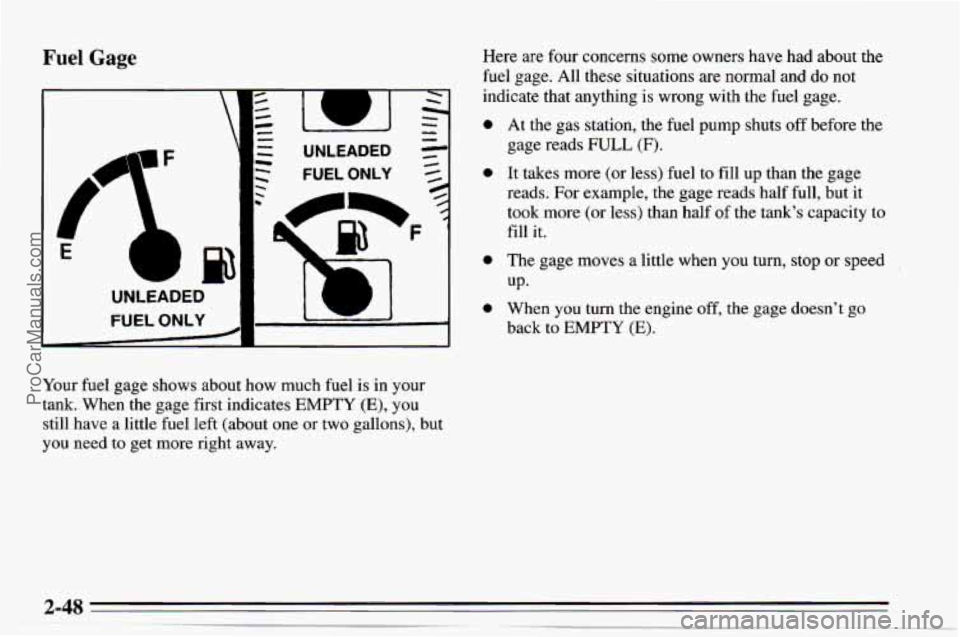
Fuel Gage Here are four concerns some owners have had about the
fuel gage. All these situations are normal and do not
indicate that anything is wrong with the fuel gage.
0
0
0
e
Your fuel gage shows about how much fuel is in your
tank. When the gage first indicates
EMPTY (E), you
still have a little fuel left (about one or two gallons), but
you need
to get more right away. At
the gas station, the fuel pump shuts off before the
gage reads
FULL (F).
It takes more (or less) fuel to fill up than the gage
reads. For example, the gage reads half full, but it
took more (or less) than half
of the tank’s capacity to
fill it.
The gage moves a little when you turn, stop or speed
UP-
When you turn the engine off, the gage doesn’t go
back to EMPTY (E).
ProCarManuals.com
Page 139 of 354
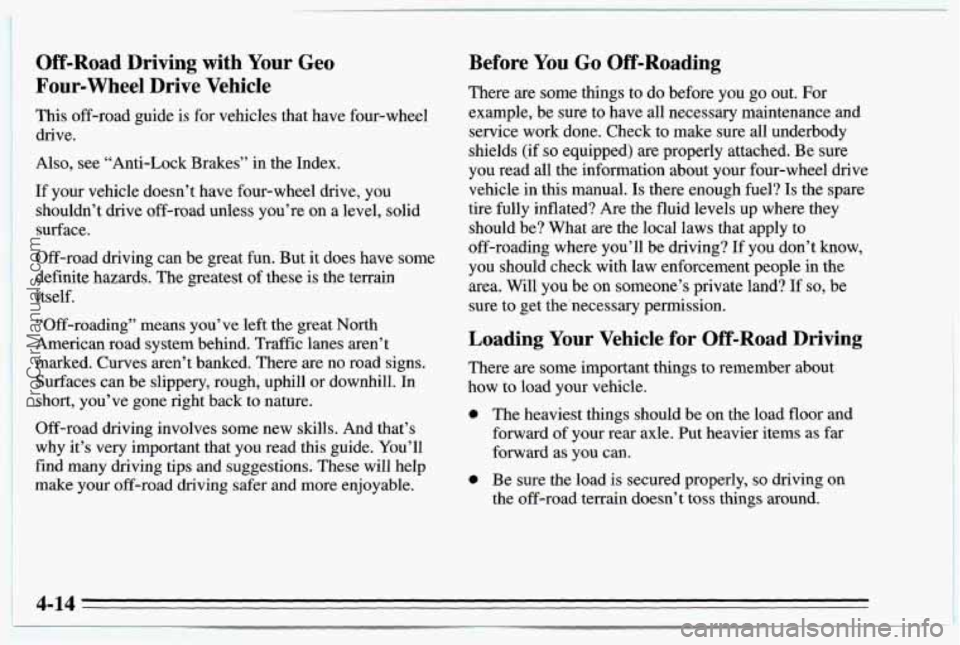
Off-Road Driving with Your Geo
Four-wheel Drive Vehicle
This off-road guide is for vehicles that have four-wheel
drive.
Also, see “Anti-Lock Brakes” in the Index.
If your vehicle doesn’t have four-wheel drive, you
shouldn’t drive off-road unless you’re on a level, solid
surface.
Off-road driving can be great fun. But it does have some
definite hazards. The greatest of these is the terrain
itself.
“Off-roading” means you’ve
left the great North
American road system behind. Traffic lanes aren’t
marked. Curves aren’t banked. There are no road signs.
Surfaces can be slippery, rough, uphill or downhill. In
short, you’ve gone right back to nature.
Off-road driving involves some new skills. And that’s
why it’s very important that you read this guide. You’ll
find many driving tips and suggestions. These will help
make your off-road driving safer and more enjoyable.
Before You Go Off-Roading
There are some things to do before you go out. For
example, be sure to have all necessary maintenance and
service work done. Check to make sure all underbody
shields (if
so equipped) are properly attached. Be sure
you read all the information about your four-wheel drive
vehicle
in this manual. Is there enough fuel? Is the spare
tire fully inflated? Are the fluid levels up where they
should be? What are the local laws that apply
to
off-roading where you’ll be driving? If you don’t know,
you should check with law enforcement people
in the
area. Will you be on someone’s private land? If
so, be
sure to get the.necessary permission.
Loading Your Vehicle for Off-Road Driving
There are some important things to remember about
how to load your vehicle.
0 The heaviest things should be on the load floor and
forward
of your rear axle. Put heavier items as far
forward as you can.
0 Be sure the load is secured properly, so driving on
the off-road terrain doesn’t toss things around.
4-14
ProCarManuals.com